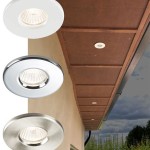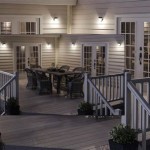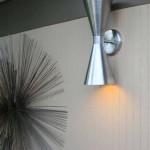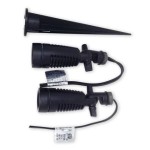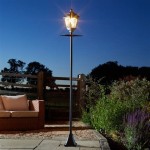Illuminating Security and Savings: A Guide to Outdoor Lighting Fixtures With Motion Sensors
Outdoor lighting is a fundamental component of home security and safety. Strategically placed lights can deter potential intruders, illuminate pathways, and enhance the overall aesthetic appeal of a property. Among the various options available, outdoor lighting fixtures with motion sensors offer a particularly effective solution. These fixtures combine the benefits of traditional outdoor lighting with the added advantage of automatic activation upon detecting movement, providing enhanced security and energy efficiency.
This article will explore the functionality, benefits, types, installation, and maintenance of outdoor lighting fixtures equipped with motion sensors. The goal is to provide comprehensive information to help property owners make informed decisions about selecting and implementing these fixtures to optimize their outdoor lighting systems.
The Functionality of Motion-Sensing Outdoor Lights
The core function of outdoor lighting fixtures with motion sensors lies in their ability to automatically activate when movement is detected within their range. This functionality is achieved through the integration of a motion sensor, which is typically a passive infrared (PIR) sensor, a microwave sensor, or a dual-technology sensor.
PIR sensors detect changes in infrared radiation, which is emitted by living beings and other heat sources. When a warm object, such as a person or animal, moves within the sensor's field of view, the sensor registers the change in infrared radiation and triggers the light to turn on. Microwave sensors, on the other hand, emit microwave radiation and detect changes in the reflected signal caused by moving objects. Dual-technology sensors combine both PIR and microwave technologies to reduce false alarms. These sensors require both technologies to be triggered before activating the light, minimizing the likelihood of activation due to environmental factors such as wind or falling leaves.
Once the motion sensor is triggered, the light remains illuminated for a preset duration, typically ranging from a few seconds to several minutes. The duration is often adjustable, allowing users to customize the lighting activation to suit their specific needs and preferences. After the preset duration expires and no further motion is detected, the light automatically turns off, conserving energy and extending the lifespan of the light bulb or LED.
Furthermore, many motion-sensing outdoor lights feature adjustable sensitivity settings. This allows users to fine-tune the sensor's responsiveness to movement, reducing the possibility of false alarms caused by small animals or distant activity. Sensitivity controls can vary greatly, enabling users to adjust the range and detection threshold. Some advanced models also include zoning features, which allow specific areas within the sensor's field of view to be excluded from triggering the light.
Benefits of Using Outdoor Lighting Fixtures with Motion Sensors
The implementation of outdoor lighting fixtures with motion sensors offers a multitude of benefits for property owners, ranging from enhanced security to energy savings and increased convenience.
Firstly, these fixtures serve as a powerful deterrent to potential intruders. The sudden illumination of a property upon detecting movement can startle burglars and discourage them from attempting to enter the premises. Strategically placed motion-sensing lights can highlight vulnerable areas, such as entrances, windows, and driveways, making it more difficult for intruders to approach unnoticed. This immediate illumination can provide valuable time for residents to react and alert authorities if necessary.
Secondly, motion-sensing lights contribute significantly to energy conservation. By only activating when movement is detected, these fixtures avoid the unnecessary consumption of electricity associated with continuous lighting. This can lead to substantial savings on electricity bills, particularly when compared to traditional outdoor lights that remain illuminated for extended periods. The use of LED bulbs in conjunction with motion sensors further enhances energy efficiency, as LEDs consume significantly less power than traditional incandescent or halogen bulbs.
Thirdly, these fixtures enhance safety by illuminating pathways and entrances, reducing the risk of accidents and injuries. This is particularly beneficial for navigating dark areas at night, such as walkways, steps, and driveways. The automatic activation of the lights provides immediate illumination, improving visibility and reducing the likelihood of trips, falls, and other accidents. For elderly residents or those with mobility limitations, this added safety can be a significant advantage.
Fourthly, motion-sensing lights provide added convenience by eliminating the need to manually switch lights on and off. This is particularly helpful when arriving home at night with arms full of groceries or other items. The lights automatically illuminate the entrance, providing a safe and convenient way to access the property. This hands-free operation can also be beneficial for individuals with disabilities who may have difficulty reaching light switches.
Finally, modern motion-sensing lights are available in a wide variety of styles and designs, allowing property owners to enhance the aesthetic appeal of their outdoor spaces. From traditional lanterns to contemporary spotlights, there are options to suit virtually any architectural style and landscaping design. The ability to choose fixtures that complement the existing décor ensures that the lighting system not only provides security and functionality but also enhances the overall beauty of the property.
Types and Considerations for Choosing Motion Sensor Lights
Outdoor lighting fixtures with motion sensors are available in a wide array of types, each with its own unique features, benefits, and drawbacks. Selecting the appropriate type for a specific application requires careful consideration of factors such as the intended purpose, the desired level of security, the aesthetic preferences, and the environmental conditions.
One common type is the integrated motion sensor light. In these fixtures, the motion sensor is seamlessly integrated into the light housing, creating a clean and streamlined appearance. These fixtures are typically easy to install and offer a cohesive design. Integrated models often come with adjustable sensor settings, allowing users to customize the sensitivity and activation duration.
Another type is the add-on motion sensor. These devices can be attached to existing outdoor lights, converting them into motion-activated fixtures. Add-on motion sensors offer a flexible and cost-effective solution for upgrading existing lighting systems. They are relatively easy to install and can be adjusted to suit different lighting configurations.
Spotlights with motion sensors are designed to provide focused illumination over a specific area. These fixtures are often used to highlight architectural features, illuminate pathways, or provide security lighting for vulnerable areas. Spotlights typically offer adjustable beam angles and intensities, allowing users to customize the lighting effect.
Floodlights with motion sensors are designed to provide broad, uniform illumination over a large area. These fixtures are commonly used for security lighting in backyards, parking lots, and other large outdoor spaces. Floodlights typically offer high light output and wide coverage, making them effective for deterring intruders and improving visibility.
In addition to the type of fixture, the choice of light source is also an important consideration. LED bulbs are increasingly popular due to their energy efficiency, long lifespan, and instant-on capabilities. Halogen bulbs offer brighter light output but consume more energy and have a shorter lifespan compared to LEDs. Incandescent bulbs are the least energy-efficient option and have the shortest lifespan, making them less desirable for outdoor lighting applications.
When choosing motion sensor lights, it is also important to consider the sensor's detection range and angle. The detection range determines how far the sensor can detect movement, while the detection angle determines the area that the sensor covers. Selecting a sensor with an appropriate range and angle ensures that the lights are activated when needed and that false alarms are minimized.
The IP (Ingress Protection) rating is another crucial factor to consider. This rating indicates the fixture's resistance to water and dust. For outdoor lighting applications, it is important to choose fixtures with a high IP rating to ensure durability and reliability in various weather conditions. A rating of IP65 or higher is generally recommended for outdoor use.
Finally, consider the ease of installation and maintenance. Choose fixtures that are easy to install and require minimal maintenance. Look for fixtures with durable construction and long-lasting components to minimize the need for repairs or replacements. Reading reviews and consulting with lighting professionals can provide valuable insights into the reliability and performance of different models.
Installation and Maintenance of Motion Sensor Lights
Proper installation and regular maintenance are essential for ensuring the optimal performance and longevity of outdoor lighting fixtures with motion sensors. Incorrect installation can compromise the functionality of the lights and potentially create safety hazards. Regular maintenance helps to prevent malfunctions and extend the lifespan of the fixtures.
Before beginning the installation process, carefully read the manufacturer's instructions and familiarize yourself with the wiring requirements. Ensure that the power supply is turned off at the breaker box before working with electrical wiring. If you are not comfortable working with electricity, it is advisable to hire a qualified electrician to perform the installation.
When positioning the lights, consider the desired coverage area and the potential for obstructions. Avoid placing the lights behind trees or bushes, as these can trigger false alarms. Position the lights at a height that provides adequate illumination without causing glare. Consider the optimal detection range and angle of the sensor when determining the placement.
When wiring the lights, ensure that all connections are secure and properly insulated. Use appropriate wire connectors and follow the manufacturer's wiring diagram. Improper wiring can cause short circuits, electrical fires, and other safety hazards. Double-check all connections before turning the power back on.
After installation, test the lights to ensure that they are functioning correctly. Adjust the sensor sensitivity and activation duration to suit your specific needs and preferences. Walk around the detection area to verify that the lights are activated when movement is detected. If the lights are not functioning as expected, consult the manufacturer's troubleshooting guide or contact a qualified electrician.
Regular maintenance is crucial for extending the lifespan of motion sensor lights. Periodically clean the light fixtures to remove dirt, dust, and debris. Use a soft cloth and mild detergent to clean the lens and housing. Avoid using abrasive cleaners or solvents, as these can damage the finish. Inspect the wiring and connections for signs of corrosion or damage. Replace any damaged components promptly.
Check the batteries in any battery-operated sensors or backup systems regularly. Replace the batteries as needed to ensure that the lights continue to function properly during power outages. Regularly inspect the motion sensor to ensure that it is not obstructed by plants or other objects. Trim any vegetation that is interfering with the sensor's field of view.
By following these installation and maintenance guidelines, property owners can ensure that their outdoor lighting fixtures with motion sensors provide reliable security, energy efficiency, and convenience for years to come.

Lnc 10 5 In H Black Seeded Glass Square Modern Motion Sensor Medium Base E 26 Outdoor Wall Light Com

Welling 14 5 High Set Of 2 Motion Sensor Porch Lights 63m74 Lamps Plus

Lnc Modern Black Motion Sensing Outdoor Sconce With Seeded Glass Shade Farmhouse 1 Light Front Door Wall Lantern 2 Pack Ev26jrhd1745dg8 The Home Depot

Dusk To Dawn Motion Sensor Outdoor Porch Lights With Gfci Waterproof Light Fixture Anti Rust Exterior Wall Mount 3 Modes For House Garage Bulb Not Included Com

John Timberland Stan Industrial Outdoor Wall Light Fixtures Set Of 2 Gray Black Motion Sensor Dusk To Dawn 15 1 Clear Glass For Post Target

Allure 13 High Black Led Motion Sensor Outdoor Wall Light 35p24 Lamps Plus

Uolfin Modern Black Outdoor Wall Light 1 Motion Sensor Lantern Sconce With Water Rippled Glass Shade Pack 628g8uefajr4744 The Home Depot

Motion Sensor Outdoor Lights 3 Lighting Modes Porch Light Fixture For House Dusk

Motion Sensor Outdoor Wall Lighting At Com

John Timberland Capistrano Mission Outdoor Wall Light Fixtures Set Of 2 Black Dusk To Dawn Motion Sensor 15 3 4 Clear Seeded Glass For Post Exterior Target
Related Posts
